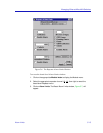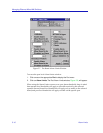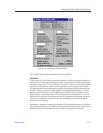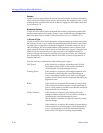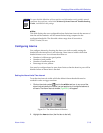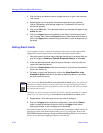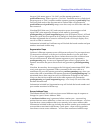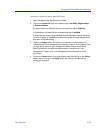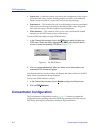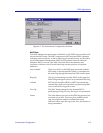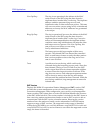
Trap Selection 5-23
Managing Ethernet MicroLAN Switches
the portÕs link status goes to ÒNo LinkÓ and the repeater generates a
portLinkDown trap. When a port in a ÒNo LinkÓ condition receives a link signal,
the port goes to a ÒLinkÓ condition and the repeater generates a portLinkUp trap.
Devices at both ends of the disconnected or broken cable will generate the
portLinkDown and portLinkUp traps, even when only one end of the cable has
been removed.
Note that BNC (thin coax), AUI, and transceiver ports do not support a link
signal. BNC ports respond to changes in link status by generating
portSegmenting and portUnsegmenting traps (see description, below); AUI and
transceiver ports do not respond at all to changes in link status (unless the port
has been segmented due to excessive collisions), and will always display as on,
even if no cable is connected.
Information included in a Link State trap will include the board number and port
number associated with the trap.
Segmentation Traps
CabletronÕs Ethernet repeaters count collisions at each port. If a port experiences
32 consecutive collisions, or if the portÕs collision detector is on for more than
2-3 µs, the repeater segments the port to isolate the source of the collisions from
the rest of the network. When the repeater segments a port, it generates a
portSegmenting trap. As soon as a segmented port receives a good packet, the
repeater reconnects the port to the network and generates a portUnsegmenting
trap.
Note that, because they do not support the Link signal, unterminated BNC (thin
coax) ports appear as segmented. When you attach a thin coax cable or a
terminator to a port, the repeater generates a portUnsegmenting trap; when you
remove the cable or terminator, the repeater generates a portSegmenting trap. As
mentioned above, these traps can serve as notiÞcation of changes in link status.
Note, too, that devices at both ends of the cable segment will generate the
portSegmenting and portUnsegmenting traps, even if only one end of the cable
has been disconnected.
Information included in a Segmentation trap will include the board number and
port number associated with the trap.
Source Address Traps
The Ethernet MicroLAN Switch can issue several different traps in response to
changes in a portÕs Source Address Table:
A newSourceAddress trap is generated when a station port Ð one receiving
packets from no source addresses, or from one or two source addresses Ð receives
a packet from a source address that is not currently in its source address table.
Information included in this trap includes the module number, port number, and
source address associated with the trap. Trunk ports Ð those receiving packets
from three or more source addresses Ð will not issue newSourceAddress traps.



